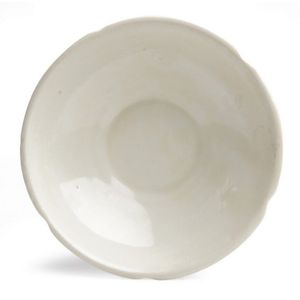Northern Song Dynasty Dingyao Foliate-Rim Bowl
You must be a subscriber, and be logged in to view price and dealer details.
Subscribe Now to view actual auction price for this item
When you subscribe, you have the option of setting the currency in which to display prices to $Au, $US, $NZ or Stg.
- Song Dynasty - The Song Dynasty was a ruling dynasty in China from 960 to 1279 AD. It was divided into two periods, the Northern Song (960?1127) and the Southern Song (1127?1279). The emperor was the ultimate authority, but he relied on officials who were selected based on their merit and skills rather than their family background or social status. The Song Dynasty was a period of great artistic and cultural achievements, particularly in the areas of poetry, painting, and calligraphy. The Chinese invented the printing press during this period, which revolutionized the spread of knowledge and ideas. During the Song Dynasty, China had a prosperous economy and was a centre of international trade, particularly in luxury goods such as silk, tea, and porcelain. The use of paper money became more widespread during this period, facilitating commerce and trade.
- Ivory - Ivory is a hard white material that comes from the tusks of elephants, mammoth, walrus and boar, or from the teeth of hippopotamus and whales. The ivory from the African elephant is the most prized source of ivory. Although the mammoth is extinct, tusks are still being unearthed in Russia and offered for sale.
Ivory has been used since the earliest times as a material for sculpture of small items, both in Europe and the east, principally China and Japan.
In Asia ivory has been carved for netsuke, seals, okimono, card cases, fan supports, animals and other figures and even as carved tusks.
In the last 200 years in Europe ivory has been used to carve figures, for elaborate tankards, snuff boxes, cane handles, embroidery and sewing accessories, in jewellery and as inlay on furniture. Its more practical uses include being used for billiard balls, buttons, and a veneers on the top of piano keys.
The use and trade of elephant ivory have become controversial because they have contributed to Due to the decline in elephant populations because of the trade in ivory, the Asian elephant was placed on Appendix One of the Convention on International Trade in Endangered Species (CITES), in 1975, and in January 1990, the African elephant was similarly listed. Under Appendix One, international trade in Asian or African elephant ivory between member countries is forbidden. Unlike trade in elephant tusks, trade in mammoth tusks is legal.
Since the invention of plastics, there have been many attempts to create an artificial ivory
This item has been included into following indexes:
-
Chinese antiquities by dynasty
- Northern Dynasties 115
- Song Dynasty 602
Visually similar items

A Chinese Song celadon shallow dish, decorated with incised lotus pattern beneath the deep olive glaze. Diameter 18 cm

Large celadon plate, with raised white glaze flower and leaf pattern to underside and rim, slight wear and light scratch to underside rim, firing flaws. Diameter 27 cm

A small white-glazed bowl, 10th century, with widely flared sides and lipped rim, springing from a broad shallow footrim, covered inside and out with an ivory tinted glaze falling unevenly short of the base, box, 12 cm diameter. Provenance: Acquired in Hon

Antique celadon bowl, with raised decoration, 22.4 cm diameter
